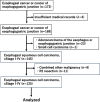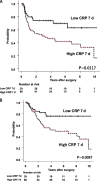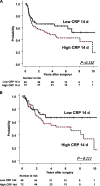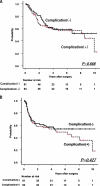The seven-day cumulative post-esophagectomy inflammatory response predicts cancer recurrence
- PMID: 39367400
- PMCID: PMC11453090
- DOI: 10.1186/s12893-024-02563-4
The seven-day cumulative post-esophagectomy inflammatory response predicts cancer recurrence
Abstract
Background: The relationship between postoperative cumulative systemic inflammation and cancer survival needs to be investigated. We developed an approach to the prognostication of postoperative esophageal cancer by establishing low and high cut-off values for the C-reactive protein (CRP) area under the curve (AUC) at 7 and 14 days after esophagectomy.
Methods: One hundred and twenty-five consecutive patients with biopsy-proven invasive esophageal squamous cell carcinoma (SCC) who underwent esophagectomies were evaluated. Postoperative CRP levels were analyzed for the first 14 days after surgery. The AUC on days 7 and 14 were calculated and compared with clinicopathological features and survival. The cut-off values for CRP at 7 days (CRP 7 d) and 14 days (CRP 14 d) were 599 mg/L and 1153 mg/L, respectively.
Results: The patients in the low CRP 7 d group had significantly better recurrence-free survival (RFS) and overall survival (OS), not that in the low CRP 14d group. The OS rates in the high CRP groups at PODs 1, 3, 10, and 14 were significantly lower than those in the low CRP groups. Postoperative complications were more common in the high CRP groups on PODs 3, 10, and 14. Univariate analyses revealed that pTNM stage, depth of tumor invasion, tumor location, lymph node involvement, and CRP 7 d were significant prognostic factors for both OS and RFS. The Cox proportional hazards model identified pTNM, tumor location, and CRP 7d as independent prognostic factors for the RFS and OS.
Conclusions: Early prediction of patients with postoperative complications, and adequate management will suppress the elevation of CRP 7 d and further suppress the CRP value in the late postoperative period, which may improve the prognosis of esophageal cancer patients after esophagectomy.
Keywords: CRP; Complications; Esophageal cancer; Esophagectomy; Prognosis.
© 2024. The Author(s).
Conflict of interest statement
The authors declare no competing interests.
Figures






Similar articles
-
Preoperative serum C-reactive protein levels and postoperative survival in patients with esophageal squamous cell carcinoma: a propensity score matching analysis.J Cardiothorac Surg. 2019 Sep 18;14(1):167. doi: 10.1186/s13019-019-0981-0. J Cardiothorac Surg. 2019. PMID: 31533862 Free PMC article.
-
Correlation Between Intense Postoperative Inflammatory Response and Survival of Esophageal Cancer Patients Who Underwent Transthoracic Esophagectomy.Ann Surg Oncol. 2015 Dec;22(13):4453-60. doi: 10.1245/s10434-015-4557-5. Epub 2015 Apr 18. Ann Surg Oncol. 2015. PMID: 25893412
-
Preoperative Glasgow Prognostic Score as additional independent prognostic parameter for patients with esophageal cancer after curative esophagectomy.Eur J Surg Oncol. 2017 Feb;43(2):445-453. doi: 10.1016/j.ejso.2016.10.015. Epub 2016 Nov 5. Eur J Surg Oncol. 2017. PMID: 27839896
-
Role of Postoperative C-Reactive Protein Levels in Predicting Prognosis After Surgical Treatment of Esophageal Cancer.World J Surg. 2017 Jun;41(6):1558-1565. doi: 10.1007/s00268-017-3900-3. World J Surg. 2017. PMID: 28120093
-
Cumulative score based on preoperative plasma fibrinogen and serum C-reactive protein could predict long-term survival for esophageal squamous cell carcinoma.Oncotarget. 2016 Sep 20;7(38):61533-61543. doi: 10.18632/oncotarget.11145. Oncotarget. 2016. PMID: 27517497 Free PMC article.
References
-
- Sung H, Ferlay J, Siegel RL, Laversanne M, Soerjomataram I, Jemal A, et al. Global cancer statistics 2020: GLOBOCAN estimates of incidence and mortality worldwide for 36 cancers in 185 countries. CA Cancer J Clin. 2021;71(3):209–49. - PubMed
-
- Dresner SM, Griffin SM. Pattern of recurrence following radical oesophagectomy with two-field lymphadenectomy. Br J Surg. 2000;87(10):1426–33. - PubMed
-
- Hulscher JB, van Sandick JW, Tijssen JG, Obertop H, van Lanschot JJ. The recurrence pattern of esophageal carcinoma after transhiatal resection. J Am Coll Surg. 2000;191(2):143–8. - PubMed
-
- Nakagawa S, Kanda T, Kosugi S, Ohashi M, Suzuki T, Hatakeyama K. Recurrence pattern of squamous cell carcinoma of the thoracic esophagus after extended radical esophagectomy with three-field lymphadenectomy. J Am Coll Surg. 2004;198(2):205–11. - PubMed
MeSH terms
Substances
LinkOut - more resources
Full Text Sources
Medical
Research Materials
Miscellaneous

